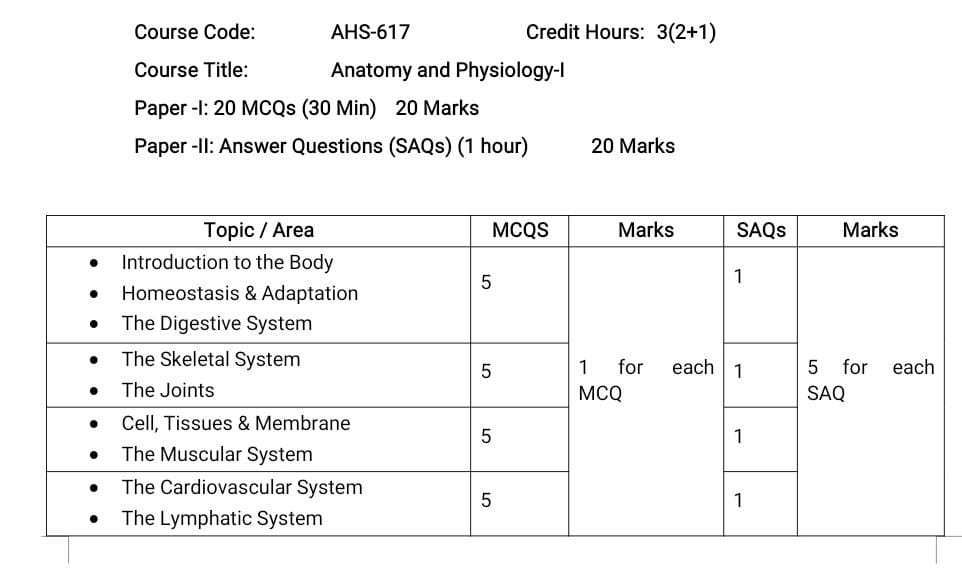Welcome to MedMedals.com! In this blog post, we’ll explore the revised curriculum of BSMLT-1 (Bachelor of Science in Medical Laboratory Technology – Semester 1), specifically focusing on Anatomy and Physiology I, as updated by NUMS (National University of Medical Sciences).
This guide is perfect for first-year BSMLT students who want a clear breakdown of their course, subject credits, and direct access to detailed lecture content for each topic.
Course Overview
Course: Anatomy and Physiology I
Course Code: AHS-617
Credit Hours: 3 (2+1)
Type: Core Subject
Learning Outcomes
a. Describe the structure and function of various systems of the human body.
b. Discuss the role of homeostasis in maintaining normal body functioning.
c. Relate the basic anatomy & physiology concepts.
Curriculum Content by Unit
Unit I: Introduction to the Body as a Whole
- Define Anatomy & Physiology (A&P)
- Understand the relationship between A&P
- Define levels of organization of the body
- Define anatomical position
- Describe the various body planes
- Define and discuss body cavities and list the organs within each
- Identify abdominopelvic regions & quadrants and their clinical relevance
Related Links:
Unit II: Homeostasis & Adaptation
- Define homeostasis
- Discuss factors affecting homeostasis
- Define feedback mechanisms and components
- Examples of positive and negative feedback mechanisms
- Related Links:
- What is Homeostasis? Understanding the Body’s Balance System
Unit III: Cell, Tissues & Membranes
- Structure and functions of the cell
- Cell division: mitosis and meiosis and their importance
- Classification of tissues:
- Epithelial
- Connective
- Muscle
- Nervous
Related Links:
Unit IV: The Skeletal System
- Definition, types and functions of bones
- Bones of axial & appendicular skeleton
- Bone markings and their significance
- Bones of the skull, vertebral column, rib cage, pectoral & pelvic girdles, and extremities
- Difference between male & female pelvis
Related Links:
Unit V: The Joints
- Definition and classification (fibrous, cartilaginous, synovial)
- Characteristics and types of synovial joints
- Movements possible at synovial joints
Unit VI: The Muscular System
- Definitions of fascia, epimysium, perimysium, endomysium, tendons, aponeurosis
- Major muscles of the face, neck, back, arms, and legs
Related Links:
Unit VII: The Cardiovascular System
- Blood composition and functions
- ABO blood groups and Rh factor
- Arteries, veins, and capillaries
- Heart structure, blood vessels, circulation pathways
- Cardiac cycle and conduction system
Related Links:
Unit VIII: The Lymphatic System
- Definition and components
- Organs of the lymphatic system: spleen, thymus, lymph nodes
- Lymph formation and circulation
- Related Links:
- The Lymphatic System
- Organs of Lymphatic System
Unit IX: The Digestive System
- Organs and functions of the digestive tract
- Accessory organs
- Digestion and absorption in various parts
- Defecation process
Related Links:
- Digestive System-Mouth & Pharynx Anatomy & Physiology
- The Digestive System Mouth and Oropharynx Physiology
- The Digestive System Stomach & Small Intestine (NUMS Curriculum)
- Large Intestine & Defecation Anatomy and Physiology
Practicals
Hands-on identification and study of:
- Muscles: Upper limb, lower limb, head & neck, thorax, abdomen, pelvis, perineum
- Bones of the body: Identification and major features
- Cardiovascular system
- Digestive system
Recommended Readings
- Ross and Wilson: Anatomy and Physiology in Health and Illness
References:
- Guyton, A. C. (2001). Medical Physiology (10th ed.). Washington: Kirokawa.
- Tortora, G. J. (2000). Principles of Human Anatomy and Physiology (3rd ed.). New York: Harper & Row.
Exam Pattern

How to Use This Article
Each listed topic in this post is hyperlinked to a detailed lecture or explanation already available on medmedals.com. Just click on the link to dive deep into that topic.
This feature is designed to make your BSMLT preparation more organized, time-efficient, and effective.
We will continue updating this space as the syllabus evolves and as we add more lectures.
Final Words
Stay connected with MedMedals for more updates on NUMS-based BSMLT content, quizzes, and notes. If you find this guide helpful, share it with your classmates and bookmark it for easy reference.
Happy Learning!
Visit More Lectures



